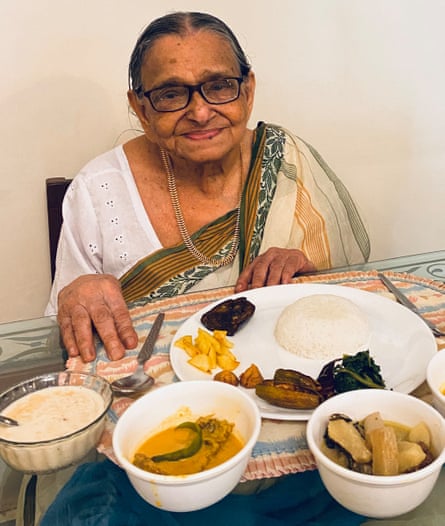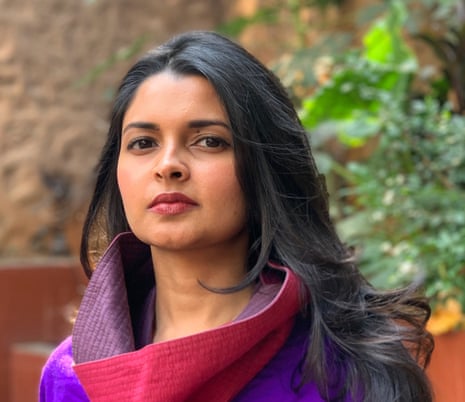I never learned how to eat an orange. It is a shameful admission. But it is because every winter, when oranges arrived in the Mumbai markets, my grandmother would make her kheer komola – sweetened milk condensed over a stovetop for hours and then cooled and mixed with fresh orange pulp. That’s how I consumed oranges through most of my childhood, with all the goodness of the fruit forked out and mixed with condensed milk. Why would I eat an orange any other way?
Bengalis are infamous for their consumption of sweets. A dessert after every meal was a requirement in our Bengali household – yes, even after breakfast. Ingenuity was sought. The rains brought a variation of the kheer. My grandmother, who I called Didu, would take on the task of peeling and deseeding a dozen custard apples for the family, coaxing out the hard black seeds from each fleshy white globule with her fingers. I often asked her why she couldn’t pick an easier fruit and she would always tell me to ask her the question after I’d had my first spoonful.
When Didu passed away at the age of 96, two years ago, my family wanted to commemorate her by recreating the dishes she appeared to make with so much ease well into her early 90s. She was a celebrated cook, but when we discussed her recipes, we were astonished by the amount of labour that went into each of these dishes, recipes she offered to make to mark birthdays, marriage anniversaries, to welcome guests or simply to enjoy during an important India-Pakistan cricket match.
The crispy fried onions that were an integral part of her yakhni pulao had to be sliced and salted and squeezed in a specific way to prevent them from over caramelising and becoming bitter. Her dimer devil (closer to Scotch eggs than devilled eggs) was a couture upgrade of the basic version that comprised half a boiled egg wrapped in minced mutton and then breaded and fried. She used to mould the minced mutton – spiced with cumin, coriander, turmeric, sliced green chilli, ginger and garlic – around the boiled egg, dust it in flour, give it an egg wash and dip it in breadcrumbs. To get a really crisp texture, she would do this twice. Her recipe had additional layers of mashed potato flanking the minced mutton to make the egg more imposing and grand in appearance. When you sliced through with a knife, you could hear the breading give way. The layers were even all around. Nothing short of slicing through an elaborate dacquoise. It was food as craft.

It was also food as care, when she made a sugarless rice pudding, year after year, for my father’s diabetic friend. For a son-in-law who struggled with deboning fish, both she and my mother went to great lengths to debone large hunks of freshwater fish, mash it with spices and pan-roast it as cutlets.
When my brother was moving to California for his masters degree, among his books and clothes was a jar of the fried dough balls we call kucho goja. They are usually dipped in a sugar syrup that is left to form a crust on the surface, but my brother was instructed how to do this in his dormitory instead, so that the treats could have an extended shelf life. It was food as a memory. (He polished them off in a week.)
“Have you eaten?” Indian mothers ask their children and husbands when they return home. The 19th-century Japanese writer Natsume Sōseki is said to have encouraged his students to translate “I love you” to “The moon is beautiful, isn’t it?” Its literal phrasing was too direct for the Japanese. “Have you eaten?” is Sōseki’s wisdom for Indians. A certain vocabulary is implicit in the exchange of food. Tea is presented to guests without inquiries being made in the north and east. In the southern parts of India, it is more likely to be coffee. As tea and coffee cannot be served by itself, there are accompaniments. We are more at ease today with serving things out of packets, but I remember visiting family in Calcutta during the summer holidays, and someone was always going out the back door as we were entering the front door. Then, 15 minutes later, shingaras and milk sweets would appear wrapped in newspaper, and these were presented on pale ceramic plates with floral patterns.
If we visited two homes the same evening, we had to eat twice, so as to not offend the host. If it was a planned visit, the accompaniments were usually prepared at home. My grandmother’s tea-time specialities were the kucho gojas and koraishutir kochuri (fried bread stuffed with peas). My other grandmother, my mother’s mother, was a champion of the dimer porota (egg roll with onions and chillies) and the Indian French toast that is savoury and loaded with onion and pepper, and certainly not something the French would recognise.
In an extended family, each woman seems to assume a trademark dish early on. That becomes her food identity in large gatherings. She is begged to make it, she is lauded for it. An aunt makes a steamed yoghurt pudding with raisins, another makes melt-in-your-mouth kebabs flavoured with rose water. My mother is an excellent cook with all manner of dishes in her repertoire, but what I need from her when I visit are the simplest of things – pink lentils, stir-fried cauliflower, fish croquettes. Food as comfort. She knows what to make, and pack for me to take back, just from looking at my face.
For food as comfort, there is no time like death. We don’t cook when there’s a death in the family. Relatives, friends and women from the neighbourhood bring food for the mourners. In reverence to the deceased, it is simple fare, austere even. But the end of the mourning period is marked with a grand feast. The menu usually comprises the favourite dishes of the departed. For Bengalis, two kinds of fish preparations are a must.
Food can be flattery. Food can be regard. I remember a heated discussion after my aunt (the one known for her steamed yoghurt) first visited her son’s girlfriend. Her son had proposed already, but she was worried the girl’s family was not serious about the marriage, because they served okra – lowly okra – for lunch.
Food memories do not always come with the trappings of love and warmth. In theories of social stratification, the preparation of food is deeply tied to the sexual division of labour. Until recently, “knows how to cook” was a perfectly acceptable requirement in matrimonial listings. In a country where millions of women often have no choice but to cook for large families – whether it is in airless kitchens in cities or bent over rustic charcoal stoves in villages – it is labour that is best not romanticised. But somehow within those limitations, a certain skill with cooking becomes a badge of resourcefulness, artistry, self-expression and identity.
Many later feminists have reframed the kitchen as a space of agency, even resistance. Didu’s sister, who survived a difficult marriage and came to live with her in Calcutta, used to make golden and glorious crisp potato slivers. She is perhaps the last person in my family I’ve known to use the traditional boti, a long curved blade that sits on a wooden platform held down by foot, and provides excellent control to the user. In a pre-food processor age, it allowed for the potato to be cut very finely. She made them in large batches and sealed them in glass jars. When we visited grandparents in Calcutta, we couldn’t have a single meal without these. If she went away for a few days, we would plead with her to come back. She also made various kinds of chutneys with mango and jaggery for us to take home after the summer holidays, ensuring she was with us until we met again the following summer.
Only as an adult did I realise the deep intelligence in these acts. I based a character in my debut novel, The Illuminated, on this grand-aunt. In the story, the otherwise disenfranchised young widow, Lata, widowed at 20, “rules the tastebuds”. Food is power. And it can be a weapon, too. For the man in his mid-40s who told me he remains in a marriage that is long over, it is a trap. He can’t leave the house because he is too accustomed to his wife’s breakfast spread. She instructs the cook to make what he has been used to since he was a child. I remember laughing when he started describing the food that had enslaved him. But I did understand his helplessness.
The Illuminated by Anindita Ghose (Head of Zeus, £15.99) is available from guardianbookshop at £13.91

Comments (…)
Sign in or create your Guardian account to join the discussion